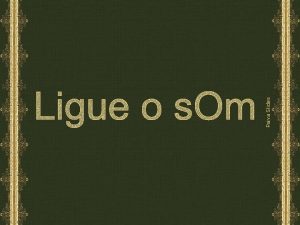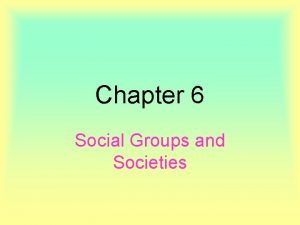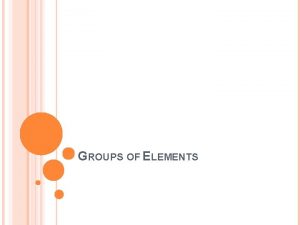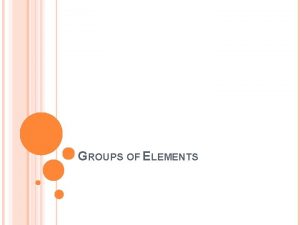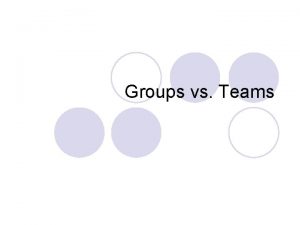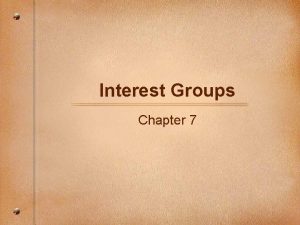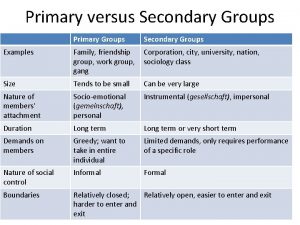CHOOSING IN GROUPS MUNGER AND MUNGER Slides for





















- Slides: 21

CHOOSING IN GROUPS MUNGER AND MUNGER Slides for Chapter 7 The Collective Choice Problem: Impossibility

Outline of Chapter 7 § Social choice § Deciding how to decide § Impossibility § Information and voting processes § Optimal majority rule § Borda count and approval voting § Proportional representation § Conclusion Slides Produced by Jeremy Spater, Duke University. All rights reserved. 2

Social choice § Deciding how to decide § Group constitution § Deciding to be a group, and membership of group § Deciding how to decide § What is decision rule? § How to change rules? § Deciding § Everyday decisionmaking § Context of constituted group with relatively static decisionmaking rules 3

Deciding how to decide § Procedure for evaluating decision procedures § § § Start with sincere preference orderings Assume membership static and uncontroversial Define feasible set Define criteria for judging decision rules Specify available set of decision rules Use criteria to select decision rule Slides Produced by Jeremy Spater, Duke University. All rights reserved. 4

Deciding how to decide (2) § Example Table 7. 1: Four Subgroups of a Larger Group Number of People in Sub-Group Preference Profile Group I: 10 persons A ≻ B ≻ C ≻ D Group II: 9 persons A ≻ C ≻ D ≻ B Group III: 8 persons D ≻ B ≻ C ≻ A Group IV: 7 persons D ≻ C ≻ A ≻ B Total Members: 34 Overall “Best” Alternative: ? ? ? § A is Condorcet winner § Other groups won’t be happy if A is always selected § Might arrange to sometimes select another outcome Slides Produced by Jeremy Spater, Duke University. All rights reserved. 5



General social choice and impossibility § Decisive set § A set of voters is decisive when their unanimous agreement is sufficient to make a decision regarding two alternatives, regardless of other group members’ preferences § Arrow’s paradox § The only choice mechanism that is complete, transitive, and obeys Pareto’s criterion is dictatorship. § Outline of impossibility theorem § Specify set of desirable characteristics for aggregation mechanism § Determine set of aggregation mechanisms that have these characteristics § Notice that dictatorship is the only aggregation mechanism with desired characteristics Slides Produced by Jeremy Spater, Duke University. All rights reserved. 8

General social choice and impossibility (2) § Desirable characteristics: Unanimity: if everyone prefers x over y, x is chosen over y Transitivity: if x preferred to y and y preferred to z, x is preferred to z Unrestricted domain: every preference ordering is possible for every individual Independence of irrelevant alternatives: pairwise comparisons aren’t affected by ranking of other alternatives § Nondictatorship: There is no voter who always gets her way regardless of other voters. § § § Impossibility theorem: § Every collective choice mechanism that satisfies the first four characteristics violates the last one. Slides Produced by Jeremy Spater, Duke University. All rights reserved. 9

Information and voting processes § The “independence of irrelevant alternatives” assumption excludes information from the voting process § Saari (2008) proposed voting mechanisms based on intensity of preferences § However, voters can falsify the intensity of their preferences § Gibbard-Satterthwaite theorem: § The alternative to dictatorship is manipulability § Takeaway: democracy isn’t perfect § Churchill: Democracy is the worst form of government except for all the others Slides Produced by Jeremy Spater, Duke University. All rights reserved. 10

Optimal majority rule § How many citizens’ consent should be required to arrive at a decision? § Tradeoff between inclusion costs and exclusion costs § Three basic types of decisions § Access decisions: bring an issue for consideration. Sub-majority (e. g. seconding a motion) § Routine decisions: adopt a policy. Simple majority. § Changing the rules: supermajority. Slides Produced by Jeremy Spater, Duke University. All rights reserved. 11


Equilibrium for larger majorities § K-majority Median Voter Theorem § Generalization of Median Voter Theorem § An alternative is an equilibrium if at least (N – K + 1) voters’ ideal points lie to either side. § Reduces to MVT for K = N/2 + 1 § Supermajority rules privilege the status quo § For K = N, every Pareto allocation is an equilibrium § As K shrinks, set of equilibria shrinks § For K = N/2, equilibrium is median voter ideal point Slides Produced by Jeremy Spater, Duke University. All rights reserved. 13



Borda count § Borda noted that plurality winner might be least preferred by a majority § Borda count: have each voter rank all alternatives § Assign “marks”: x gets one mark for each voter who ranks x first, two for second, etc. § Alternative with fewest “marks” wins § In practice some voters might not supply complete ranks § Rule for dealing with abstentions can affect outcome § Voters can lie (supply false rankings) to manipulate outcome Slides Produced by Jeremy Spater, Duke University. All rights reserved. 16


Approval voting § Each voter vote for as many candidates as she likes § Candidate with most votes wins § Both Borda and approval voting violate Independence of Irrelevant Alternatives § Voters can strategically move alternatives up and down in the ranking to manipulate result § Borda is not path-independent § Depends on presence or absence of alternatives § Example on next slide shows effect of excluding an alternative on outcome Slides Produced by Jeremy Spater, Duke University. All rights reserved. 18

Approval voting (2) Table 7. 2: With Borda Count, Alternatives Matter Too Much Panel a: A comparison of x, z, and w with y also considered Rank of alternative A B C Borda count x 1 2 2 5 z 4 1 1 6 w 2 4 4 10 y 3 3 3 9 Panel b: A comparison of x; z, and w, deleting y Rank of alternative A B C Borda count x 1 2 2 5 z 3 1 1 5 w 2 3 3 8 Slides Produced by Jeremy Spater, Duke University. All rights reserved. 19

Proportional representation § Parties are awarded a proportion of seats based on their proportion of votes § A threshold is often imposed: below threshold, party gets no seats § Seating representatives is just the beginning: parties must form a coalition § Plurality or majority versus proportional representation: § Plurality or majority is often more expedient § Proportional representation includes a wider range of viewpoints Slides Produced by Jeremy Spater, Duke University. All rights reserved. 20

Conclusion § Cox ’ 87: “degree of centrism” axis § Condorcet: maximum centrism § Candidates’ dominant strategy is to converge at median voter’s ideal point § Borda and approval voting § Nash equilibrium is for candidates to converge at median voter’s ideal point § Plurality rule: least centrism § Candidates spread themselves evenly across policy space § Impossibility theorem highlights difficulty of stable democratic rule § Alternative is dictatorship, which is unpalatable Slides Produced by Jeremy Spater, Duke University. All rights reserved. 21
 Philosophy, politics and economics michael munger
Philosophy, politics and economics michael munger Michael munger duke
Michael munger duke Brian munger
Brian munger How are ethnic groups and religious groups related
How are ethnic groups and religious groups related A small child slides down the four frictionless slides
A small child slides down the four frictionless slides Change in energy quick check
Change in energy quick check Result approach in measuring performance
Result approach in measuring performance Approaches to measuring performance
Approaches to measuring performance Penentuan lokasi dan tata letak (layout)
Penentuan lokasi dan tata letak (layout) Choosing and narrowing a topic
Choosing and narrowing a topic Narrowing topic
Narrowing topic Fspos
Fspos Typiska novell drag
Typiska novell drag Nationell inriktning för artificiell intelligens
Nationell inriktning för artificiell intelligens Vad står k.r.å.k.a.n för
Vad står k.r.å.k.a.n för Shingelfrisyren
Shingelfrisyren En lathund för arbete med kontinuitetshantering
En lathund för arbete med kontinuitetshantering Personalliggare bygg undantag
Personalliggare bygg undantag Vilotidsbok
Vilotidsbok A gastrica
A gastrica Förklara densitet för barn
Förklara densitet för barn Datorkunskap för nybörjare
Datorkunskap för nybörjare




























